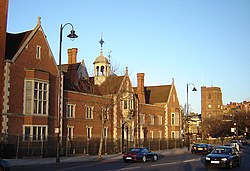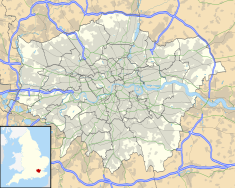Crosby Place
| Crosby Hall | |
|---|---|
 |
|
| Location | Cheyne Walk, Chelsea, London |
| Coordinates | 51°28′56.94″N 0°10′21.52″W / 51.4824833°N 0.1726444°WCoordinates: 51°28′56.94″N 0°10′21.52″W / 51.4824833°N 0.1726444°W |
| Built | 1466 (Great Hall and Parlour) 1910, 1925–6 (Remainder) |
|
Listed Building – Grade II*
|
|
| Official name: Crosby Hall | |
| Designated | 24 June 1954 |
| Reference no. | 203744 |
Crosby Hall is a historic building in London. The Great Hall was built in 1466 and originally stood in Bishopsgate, in the City of London, but was moved in 1910 to its present site in Cheyne Walk, Chelsea. It now forms part of a private residence. The Great Hall, and additional work of 1910 and 1925–6, are listed Grade II*. Although fragmentary and not on its original site, this is the only example of a medieval City merchant house surviving in London.
The Great Hall is the only surviving part of the medieval mansion of Crosby Hall, Bishopsgate, in the City of London, which was built in 1466 by the wool merchant Sir John Crosby. By 1483, the Duke of Gloucester, later Richard III, had acquired the Bishopsgate property from the original owner's widow. The Hall was used as one of his London homes. It was used as the setting for a scene in William Shakespeare's Richard III. In the reign of Henry VIII it belonged to Antonio Bonvisi.
From 1621 to 1638 it was the home of the East India Company. Following a fire in 1672 only the Great Hall and Parlour wing of the mansion survived; it then became a Presbyterian meeting house, and then a warehouse with an inserted floor.
In 1910, the medieval structure was reprieved from threatened demolition and moved stone by stone to its present site, provided by the former London County Council, largely at public expense. The neo-Tudor brick additions designed by Walter Godfrey were constructed around it. The salvage, catalogue and storage were paid for by the Bank of India, who had purchased the Bishopsgate site to build offices. In 1916, the building housed Belgian refugees, as noted in an essay by Henry James.
...
Wikipedia

